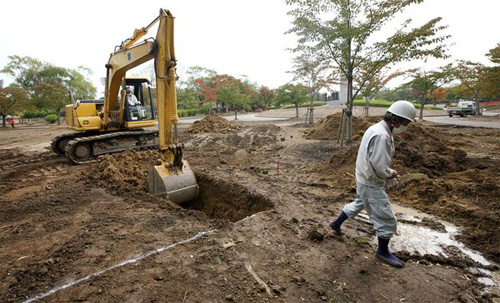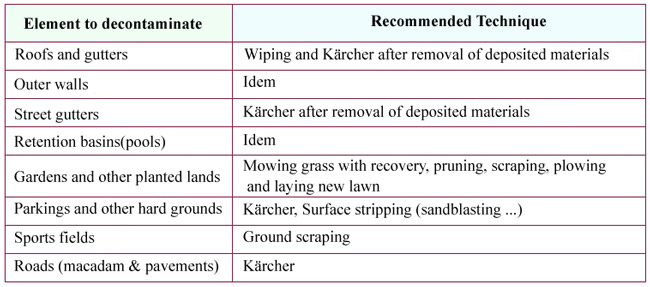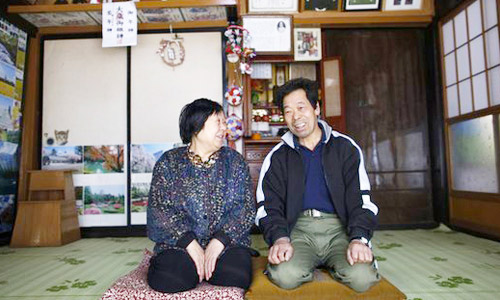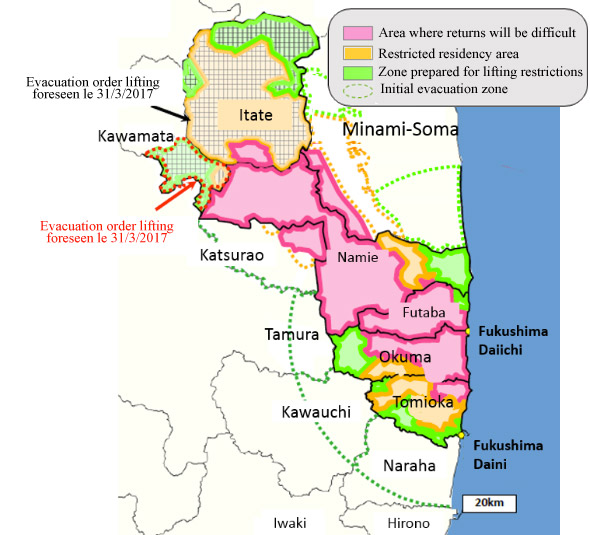2014 -2017: Status of clean-up operations
The major clean-up program of contaminated areas in Japan has progressed considerably. The levels of contamination have decreased csignificantly, which makes it possible to envisage a gradual return of evacuated areas inhabitants. However, in some areas, such as forests, decontamination is much more difficult and slower to implement.

Decontamination operation
This excerpt from a report by National Geographic Magazine shows a decontamination operation. Where the level of contamination washigh, one scraped the soil to remove cesium atoms deposited on the ground.
© National Geographic Magazine
One distinguishes for the clean-up : Special decontamination areas where people have been evacuated and where the government, responsible of decontamination, chooses the companies responsible for the work; Extensive surveillance zones whose populations have not been evacuated but where a decontamination is necessary and the communities are responsible for decontamination under the supervision of the Ministry of the Environment.
The Special Decontamination Zone covers 11 communes: the cleaning design is actively engaged for 10 of them. Places with an annual exposure greater than 50 millisieverts  per year would be declared uninhabitable. Where this yearly exposure is below 50 millisieverts per year, decontamination operations are designed to bring down this level below 20 millisieverts and allow residents to return. Where the exposure dose is between 1 and 20 millisieverts per year, the next return of populations is expected.
per year would be declared uninhabitable. Where this yearly exposure is below 50 millisieverts per year, decontamination operations are designed to bring down this level below 20 millisieverts and allow residents to return. Where the exposure dose is between 1 and 20 millisieverts per year, the next return of populations is expected.
The Extensive Surveillance Zone includes 100 communes, whose population has not been evacuated. The clean-up iomplementation of sanitation is planned to last up to 5 years in the Fukushima Prefecture. The initial principle was to take into account ground contamination levels, irrespective of the time of on-site presence. Now decontamination is based on the effective dose accumulated by the public. For instance, in forests where people do not live permanently, decontamination can be less rigourous than in the agricultural lands.
The Japanese National Safety Authority (NRA) has demonstrated that the risk of exposure due to radiation in non-evacuated areas is low. The doses actually measured by personal dosimeters are 2.6 to 7 times lower than the estimates based on ground and air measurements.

Clean-up techniques
The point was to reduce exposure by eliminating radioactive contamination of the human environment through large-scale measures: scraping of ground and leaves, washing or wiping the surface contaminated with various objects, etc. One may also overlay contaminated grounds with clean earth, and plough fields and gardens.
© Source SFEN
As a first step, more than 26,000 hectares of decontaminated agricultural land have been put back into production (mainly rice). Controls of agricultural products have shown that virtually all decontaminated lands produces food with radioactivity levels below allowed limits. For example, in 2012, only 71 bags of rice out of 10 million exceeded the norm in the Fukushima prefecture.
This surprising low rate is not solely due to decontamination. March 2011 radioactive deposits occurred during early spring contaminating young grass and leaves, while in the following years the plant contaminations that occured through the roots were much lower.
Radioactive waste, dumped on sites near decontamination areas must be stored for the long term in a safer manner. In December 2013, the Japanese State took over the creation of a storage site for these residues, with an area of 3 to 5 square kilometers. It is planned to store the soil, leaves, radioactive grasses collected there for a period of about 30 years. A sufficiently thick protective earth cover will absorb gamma rays and protects the vegetation. The important thing is to avoid a circulation of water.
In the fields, public and private gardens, and around schools with children, the priority was to scrape the top layer of soil about 5 cm deep. 75 to 97% of soil radioactivity have been eliminated. As a result: 22 million m3 of contaminated soil have since been stored on dedicated sites, collected in so-called big bags. The Japanese authorities are looking for the best technologies to get rid of their radioactivity, mainly due to cesium-137. Nine projects were selected in 2017 for testing.
An example of the decontamination actions undertaken by the municipalities of the Fukushima Prefecture was the use of bulldozers to scrape and remove contaminated soil around schools and schoolyards. The aim was to reduce the annual exposure of schoolchildren below the legal limit of 1 millisievert / year. By October 2013, 400 school yards had been properly decontaminated.

April 2014: First returns to Tamura
Approximately 350 residents were allowed to return on 1 April 2014 to the Miyakoki district of the Tamura municipality within the 20 km exclusion zone. How many of these residents will return? According to Kimiko Koyama, 69, left on the photo; « Many of our friends and neighbors will not come back. There is no work, it is not convenient and young people are afraid of radiation. »
© BBC / Reuters
First returns. How many people one could have avoided to evacuate?
Among the 11 communes in the Special Decontamination Zone, the first clean-up to be completed was in Tamura, the first municipality where the evacuation order was lifted. The return of the inhabitants was authorized from the beginning of April 2014.
In September 2015, the Japanese authorities invited the inhabitants of Narana to return to their city. This small town, 20 km from the plant, was completely evacuated in 2011 and was the first to allow the permanent return of its population after several years of decontamination. According to a BBC report, only 46% of residents expected to return.
In an interesting interview given in March 2016 in Les Echos, M.Jacques Répussard, director of the IRSN (french Istitute of Radioprotection and Nuclar Safety), questions the social and economic cost of evacuations, sometimes based on an overestimation of risks: “Researchers at the Tokyo University equipped with dosimeters workers who used to go to an evacuated area during the day. To their surprise, their dose was found to be one-third to one-half lower than expected the dose limit which had motivated the evacuation of the area. This is due to the fact that experts are trained to take safety margins to be certain to properly prevent risks « ..
Recognizing the high economic and social cost of evacuations, and the many lives shortened by uprooting of their environment, M.Repussard recommends not to evacuate as a precaution, but on the basis of a realistic estimate of the risk: « There were 200,000 evacuees , it may have been necessary to permanently evacuate only half … « .

Map of first authorized returns
As the decontamination program for the territories has progressed considerably, lower levels of contamination allowed the gradual return of inhabitants to some evacuated areas. Since April 2014 the return to all or parts of 6 communes has been authorized, including that of Tamura and Naraha (either for permanent stays or for the day only). In 2017, other return authorizations were foreseen, in particular at Itate, the district the most far away from the nuclear plant and located in the mountain.
© IRSN
Since April 2014, returns have been authorized in 6 communes, where the exposure dose had dropped below 20 millisieverts per year. These returns should be accompanied at the end of March 2017 by a cessation of housing aids paid to the evacuees.
This decision is being challenged by organizations for whom the 20 mSv limit is too risky. But the risk of a future cancer resulting from such exposures, is very low according to the standard rule, less than 1 thousandth per year, probably less for people of a certain age. It must be put in perspective with the trauma of the evacuation and the importance for many to regain their lives environment and their homes.
By early 2016, 79,000 people were still displaced, including 48,000 in Fukushima Prefecture. Many families and individuals, especially young people, have restarted their lives in other territories. Three-quarters of the 25,000 people who had voluntarily left Fukushima prefecture did not intend to return, especially because, despite the efforts of the government, the economic activity is slow to restart.
Is Fukushima’s exclusion zone doing more harm than radiation?, marsch 2016, Rupert Wingfield-Hayes (BBC News, Tokyo)
Growing crops in the shadow of Fukushima? 29 may 2019 (BBC News, Tokyo)
Learn more :
MilliSievert
Doses legal limits
Low Doses Effects
BBC News (april 2014) : First Fukushima evacuees return to exclusion-zone homes
NGM pictures: The Nuclear Cleanup Struggle at Fukushima
Other articles on the subject « Fukushima accident »
Fukushima : Events and Causes
March 11th 2011 : cascade of unlikely accidents … The earthquake The magnitude 9 earthquake[...]
Fukushima : Contaminations
Atmospheric releases and map of ground déposits The contaminations due to Fukushima radioactive r[...]
Fukushima Health Impact
Contamination and health controls in Japan The health impacts of the accident primarily concerned[...]
Fukushima today
A long way from reactors cold shutdown to their dismantling .. Today, 8 years after the accident,[...]